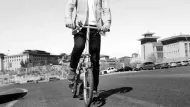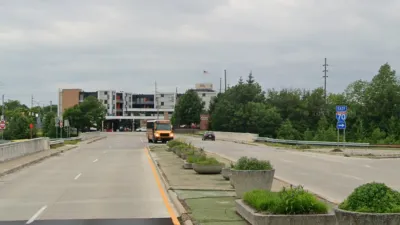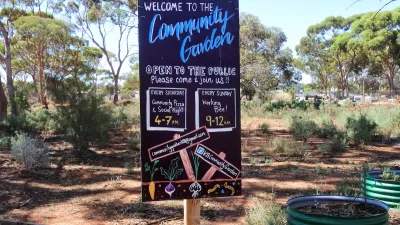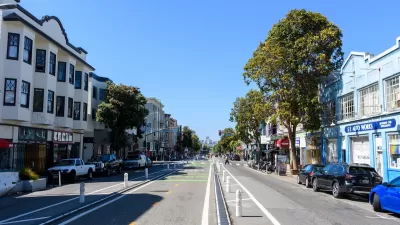In part one of a two-part series, I introduce MoMA's latest Issues in Contemporary Architecture exhibit and offer a definition of Tactical Urbanism.

In Santiago, Chile, a group of people used plastic cups, shipping pallets, and paint to transform a lifeless parking lot into a vibrant public space while construction of an underground metro line limited surface-level access for cars.
Over in Christchurch, New Zealand, countless numbers of citizens have developed more than 200 temporary "adaptive urbanism" projects that have helped heal and bring life back to their earth-quaked city.
And in Los Angeles, the city’s Department of Transportation has created People St., a public space program stocked with a pre-approved kit of parts and a streamlined approval process allowing businesses, organizations, and other neighborhood stewards to implement three types of block-level interventions.
These projects and hundreds of others demonstrate that Tactical Urbanism is a global movement owned by no one, that can involve anyone, and at its best, seeks to improve the lives of everyone. This final assertion—that Tactical Urbanism can be applied in settings where equity gaps loom the largest—is the subject of choice in the Museum of Modern Art (MoMA) exhibit Uneven Growth: Tactical Urbanisms For Expanding Megacities.
Because the issues the exhibit seeks to address are complex and overwhelming, and the tools purportedly applied "tactical," Uneven Growth is perhaps the most ambitious of MoMA's Issues in Contemporary Architecture series. Selected for the challenge are six international design "collaboratives" assembled by architect/curator Pedro Gadahno, who tasked each group with developing speculative proposals that tackle notoriously knotty urban development issues in Mumbai, Hong Kong, New York City, Lagos, Rio De Janeiro, and Istanbul.
At Street Plans, we’ve documented, defined, shared, and applied Tactical Urbanism to projects globally. In this practice we’ve witnessed both great successes and informative failures in small towns as well as in some of the megacities listed above. However, the outcomes have revealed valuable lessons regarding the often surprising achievements, but also the very real limitations, of Tactical Urbanism. Thus, you can imagine our curiosity was piqued when MoMA announced Uneven Growth to the public. We wondered what types of projects would be included? Can tactical urbanisms (Gadanho offers the plural) provide "design solutions for future urban developments" that mitigate entrenched poverty, sea level rise, and rapid urbanization? How do art institutions and designers take academic exercises and put them into action? Can they? Should they? Have they?
Seeking answers to these questions and others, a small group of urbanists—several of whom were with me in New Orleans in late 2010 when we began to apply the term “Tactical Urbanism” to a variety of emergent project types—recently reviewed the exhibit. Before I share my personal thoughts in Part Two of this blog post, I thought it might be helpful to first answer a fundamental question that some readers might be asking: What the heck is Tactical Urbanism?
Tactical Urbanism is a city, organizational, and/or citizen-led approach to neighborhood building using short-term, low-cost, and scalable interventions intended to catalyze long-term change. Its practitioners believe firmly that pregnant project budgets, years- or decades-long timelines, and convoluted/outdated project delivery processes should not be pre-requisites for delivering change.
Tactical urbanists view very real constraints—spatial, economic, political—as opportunities rather than as barriers; they start small and work incrementally on purpose so that they may try out ideas that might make a big impact quickly.
According to Merriam-Webster, "tactical" means "adroit in planning or maneuvering to accomplish a purpose." This best describes short-term efforts that seek long-term changes in policy, the physical environment, or both. In fact, that's the whole point. Action delivered quickly can build long-term momentum, and the momentum begets still more action, which helps the informal become more formal, the tenuous to become more viable.
Tactical Urbanism occurs all over the world, but in the North American context we attribute its rise to the increasing frustration people have with outdated project delivery processes found at all levels of government; the ubiquity of low-cost digital communication tools—what author Nicco Mele calls radical connectivity—allowing us to witness as well as share more nimble project delivery methods; an ongoing global demographic shift to more urban contexts that puts increased pressure on accommodating growth; and the economic fallout associated with the Great Recession, where all but the most wealthy took on the weight of doing more with less.
Despite the reputation as a guerrilla or informal movement of sorts, Tactical Urbanism projects are realized by a variety of actors. The roster includes citizen-activists, developers, local businesses, artists, NGOs, and government entities. This last group—the bureaucrats and technocrats amongst us—have become somewhat unexpected but absolutely necessary enablers and even enthusiastic practitioners of Tactical Urbanism. As it turns out, many government officials are just as, if not more frustrated with systemic shortcomings as the people they serve.
So far, we've seen Tactical Urbanism applied in many ways, but the three most common applications are as follows:
1) Unsanctioned Citizen Action - People alter the physical environment as a means to achieve a desired end and to build political momentum.
2) Expand Public involvement - Municipalities, organizations, and/or property owners seek to widen and increase public involvement opportunities during a formal planning process by working directly with citizens to build out a project that may be experienced and commented on in real-time.
3) "Test before You Invest" - Governments/property owners have long-term plans but want to first test out designs or possible uses so that feedback, data, and information may be gathered before more substantial resources are committed.
Of course, there are many other permutations and in the context of the exhibit introduced above, a marked difference exists when applying Tactical Urbanism to so-called megacities. A review of Uneven Growth and how it supports and differs from the above definition and applications will be the subject of my next blog post.

Planetizen Federal Action Tracker
A weekly monitor of how Trump’s orders and actions are impacting planners and planning in America.

Congressman Proposes Bill to Rename DC Metro “Trump Train”
The Make Autorail Great Again Act would withhold federal funding to the system until the Washington Metropolitan Area Transit Authority (WMATA), rebrands as the Washington Metropolitan Authority for Greater Access (WMAGA).

DARTSpace Platform Streamlines Dallas TOD Application Process
The Dallas transit agency hopes a shorter permitting timeline will boost transit-oriented development around rail stations.

Parks: Essential Community Infrastructure — and a Smart Investment
Even during times of budget constraint, continued investment in parks is critical, as they provide proven benefits to public health, safety, climate resilience, and community well-being — particularly for under-resourced communities.

Porches, Pets, and the People We Grow Old With
Neighborhood connections and animal companions matter to aging with dignity, and how we build can support them. Here’s a human-scale proposal for aging in place.

Single-Stair Design Contest Envisions Human-Scale Buildings
Single-stair building construction is having a resurgence in the United States, where, for the last several decades, zoning codes have required more than one staircase in multi-story housing developments.
Urban Design for Planners 1: Software Tools
This six-course series explores essential urban design concepts using open source software and equips planners with the tools they need to participate fully in the urban design process.
Planning for Universal Design
Learn the tools for implementing Universal Design in planning regulations.
City of Charlotte
Municipality of Princeton
City of Camden Redevelopment Agency
City of Astoria
Transportation Research & Education Center (TREC) at Portland State University
US High Speed Rail Association
City of Camden Redevelopment Agency
Municipality of Princeton (NJ)






























